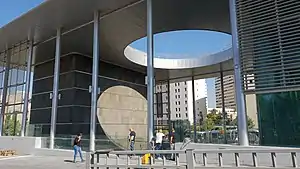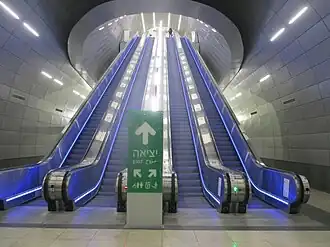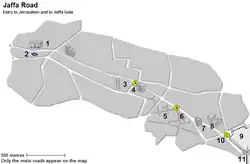Jerusalem–Yitzhak Navon railway station
Jerusalem–Yitzhak Navon Railway Station (Hebrew: תחנת הרכבת ירושלים – יצחק נבון, Tahanat HaRakevet Yerushalaim–Yitzhak Navon; Arabic: محطة أورشليم – يتسحاق ناڤون), originally named Jerusalem–HaUma railway station is an Israel Railways passenger terminal in Jerusalem, located at 6 Shazar Avenue.[4]
Jerusalem–Yitzhak Navon railway station תחנת הרכבת ירושלים–יצחק נבון محطة أورشليم – يتسحاق ناڤون .jpg.webp) | |
|---|---|
| Israel Railways inter-city rail station | |
 Surface vestibule | |
| General information | |
| Location | 6 Shazar Avenue, Jerusalem |
| Coordinates | 31.788219°N 35.202439°E |
| Operated by | Israel Railways |
| Line(s) | Tel Aviv–Jerusalem railway |
| Platforms | 2 |
| Tracks | 4 |
| Train operators | Israel Railways |
| Connections | Jerusalem Central Bus Station, Jerusalem Light Rail |
| Construction | |
| Structure type | Deep-level pylon three-vault station |
| Depth | 80 metres (260 ft) |
| Accessible | Yes |
| Architect | Barchana Architects |
| Architectural style | Neo-futurism |
| Other information | |
| Website | rail.co.il |
| History | |
| Opened | 25 September 2018[1][2] |
| Electrified | at opening |
| Passengers | |
| 2020 | 1,651,659[3] |
| Rank | 5 out of 68 |

The station is the eastern terminus of the Tel Aviv–Jerusalem railway. It is the world's deepest heavy-rail passenger station, the fourth deepest underground station in the world, and the deepest underground station outside the former Soviet Union, with its platforms extending down to 80 metres (260 ft) below street level.[5] It is located across from Binyanei HaUma and constitutes part of a major public transportation hub, being situated adjacent to the Jerusalem Central Bus Station as well as next to a station serving current and future lines of the Jerusalem Light Rail.
The station is named after Jerusalem native Yitzhak Navon, the fifth President of Israel.
History
Construction of the station began in 2007 and was completed in 2018 at a cost of about NIS 500 million (appx. US$140 million).[6]
2,674,840 passengers boarded or disembarked at the station in 2019,[7] making it the 16th busiest station in the country overall at the time. As electrification works progressed northwards along the line, direct services from Tel Aviv were made possible without the need for a transfer at Ben-Gurion Airport and as a result the station's ridership rankings rose further – making it the fifth-busiest railway station in the country and the busiest outside of Tel Aviv (immediately above the previous holder of this title, Haifa Hof HaCarmel) with 1,651,659 passengers boarding or disembarking in 2020.
In 2021, 3,598,443 passengers embarked and disembarked, not only surpassing the (2019) pre-COVID traffic numbers, but also making Navon station the fourth-busiest in the network, above Tel Aviv University.[8]
In 2022, Navon Station reached a ridership of 6,536,393,[9] nearly double that of the previous year, placing it behind only the Savidor Central and HaShalom stations in central Tel Aviv. 2022 also marked the opening of a second line served by the station, connecting Jerusalem with Modi'in, as well as the beginning of nighttime services;[10] initially only between Jerusalem and Tel Aviv Savidor, with a stop at Ben Gurion Airport, these services were extended in 2023 to stop at Herzliya, Netanya, Hadera and Binyamina,[11] continuing well north of the daytime services (which still terminate at Herzliya).
Station structure
Due to the constraints of building the Tel Aviv–Jerusalem railway in a grade suitable for carrying passengers, the station platforms had to be built 80 metres (260 ft) below street level, at the end of a tunnel leading to the railroad bridge over Emeq HaArazim.
The underground portion of the station is built as a pylon tri-vault. The side vaults each host one of the two island platforms, and are linked by three pairs of overpasses to the central vault. The length of the platforms is 300 metres (980 ft),[12] and the temperature inside remains consistent year-round.
The central vault itself contains the escalators, high-speed elevators and stairways leading up to the surface vestibule 60 metres (200 ft) above, where the station offices, ticket offices, station café and other services are located.
The surface vestibule is located at an elevation of 815 metres (2,674 ft), with most of the station's 60,000 square metres (650,000 sq ft) of floorspace located underground.[5] The lion's share of the underground portion is home to vast logistical and operating areas. The station can double as a shelter in case of a conventional, biological or chemical attack, being able to provide refuge for 5,000 people.[13] Due to the station's vast depth, its underground portion has large ventilation systems pulling in air directly from the surface level, which are also capable of quickly sucking out air in the event of a fire.
Future plans
As of 2022, additional surface entrances from the east and south are being added as part of a major urban re-development plan being carried out in the vicinity of the station.
There is a proposed plan to extend the railway from the station towards the Jerusalem–Malha railway station, via a new underground station in central Jerusalem and another underneath the historic Jerusalem-Khan train station.
Station layout
Platform numbers increase in a North-to-South direction
| +1 | Street level | Light Rail, buses | |
| Light Rail station | Central Bus Station entrance | ||
| Side platform | |||
| Southbound | ← Red Line toward Mount Herzl (Kiryat Moshe) | ||
| Northbound | Red Line toward Heil Ha-Avir (Ha-Turim) → | ||
| Side platform | |||
| Navon Station entrance | |||
| 0 | Entrance level | Exterior plaza, security checkpoint, ticket machines, underpass to Central Bus Station | |
| -1 | Passenger hall | Fare control, ticket machines, station master's office, convenience store, station café, synagogue, toilets | |
| -2 | Passageway to the platforms | Children's play area, station café, toilets | |
| -3 | Platforms | Platform 1 | ← Herzliya–Jerusalem Returning toward Herzliya (Ben Gurion Airport) ← Binyamina–Jerusalem Returning toward Binyamina (Ben Gurion Airport) during night hours only, except on Wed.-Thu. nights |
| Island platform | |||
| Platform 2 | ← Herzliya–Jerusalem Returning toward Herzliya (Ben Gurion Airport) ← Binyamina–Jerusalem Returning toward Binyamina (Ben Gurion Airport) during night hours only, except on Wed.-Thu. nights | ||
| Platform 3 | ← Herzliya–Jerusalem Returning toward Herzliya (Ben Gurion Airport) | ||
| Island platform | |||
| Platform 4 | ← Jerusalem–Modi'in Returning toward Modi'in Central (Pa'atei Modi'in) | ||
Ridership
| Year | Passengers | Rank | Source |
|---|---|---|---|
| 2022 | 6,536,393 ( |
3 of 66 ( |
2022 Freedom of Information Law Annual Report |
| 2021 | 3,598,443 ( |
4 of 66 ( |
2021 Freedom of Information Law Annual Report |
| 2020 | 1,651,659 ( |
5 of 68 ( |
2020 Freedom of Information Law Annual Report |
| 2019 | 2,674,840 | 16 of 68 | 2019 Freedom of Information Law Annual Report |
Station lines
Jerusalem– Herzliya/Binyamina Line | |||||||||||||||||||||||||||||||||||||||||||||||||||||||||||||||||||||||||||||||||||||||||||||||||||||||||||||||||||||||||||||||||||||||||||||||||||||||||||||||||||||||||||||||||||||||||||||||||||||||||||||||||||||||||||||||||||||||||||||||||||||||||||||||||||||||||||||||||||||||||||||||||
|---|---|---|---|---|---|---|---|---|---|---|---|---|---|---|---|---|---|---|---|---|---|---|---|---|---|---|---|---|---|---|---|---|---|---|---|---|---|---|---|---|---|---|---|---|---|---|---|---|---|---|---|---|---|---|---|---|---|---|---|---|---|---|---|---|---|---|---|---|---|---|---|---|---|---|---|---|---|---|---|---|---|---|---|---|---|---|---|---|---|---|---|---|---|---|---|---|---|---|---|---|---|---|---|---|---|---|---|---|---|---|---|---|---|---|---|---|---|---|---|---|---|---|---|---|---|---|---|---|---|---|---|---|---|---|---|---|---|---|---|---|---|---|---|---|---|---|---|---|---|---|---|---|---|---|---|---|---|---|---|---|---|---|---|---|---|---|---|---|---|---|---|---|---|---|---|---|---|---|---|---|---|---|---|---|---|---|---|---|---|---|---|---|---|---|---|---|---|---|---|---|---|---|---|---|---|---|---|---|---|---|---|---|---|---|---|---|---|---|---|---|---|---|---|---|---|---|---|---|---|---|---|---|---|---|---|---|---|---|---|---|---|---|---|---|---|---|---|---|---|---|---|---|---|---|---|---|---|---|---|---|---|---|---|---|---|---|---|---|---|---|---|---|---|---|---|---|---|---|---|---|---|---|---|---|---|---|---|---|---|
| |||||||||||||||||||||||||||||||||||||||||||||||||||||||||||||||||||||||||||||||||||||||||||||||||||||||||||||||||||||||||||||||||||||||||||||||||||||||||||||||||||||||||||||||||||||||||||||||||||||||||||||||||||||||||||||||||||||||||||||||||||||||||||||||||||||||||||||||||||||||||||||||||
| Preceding station | Following station | |||
|---|---|---|---|---|
| Ben Gurion Airport towards Herzliya |
Herzliya–Jerusalem | Terminus | ||
| Terminus | Jerusalem–Modi'in | Pa'atei Modi'in towards Modi'in Central | ||
| Ben Gurion Airport towards Binyamina |
Binyamina–Jerusalem | Terminus | ||
References
- Inauguration of the Yitzchak Navon Train Station in Jerusalem
- Opening of Jerusalem-Tel Aviv train route delayed by six months, Arutz Sheva, 21 February 2018
- "2020 Freedom of Information Law Annual Report" (PDF). Israel Railways.
- "ירושלים - יצחק נבון".
- Riva, Na'ama (26 September 2018). "מפלצת תת-קרקעית: תחנת הרכבת החדשה יכולה לשנות את ירושלים" [Underground Monster: The New Railway Station Can Change Jerusalem] (in Hebrew). TheMarker. Retrieved 30 September 2018.
- "מפלצת תת-קרקעית: תחנת הרכבת החדשה יכולה לשנות את ירושלים - הארץ - הארץ". www.haaretz.co.il. Archived from the original on 27 September 2018. Retrieved 14 January 2022.
- "2019 Freedom of Information Law Annual Report" (PDF). Israel Railways.
- "2021 Freedom of Information Law Annual Report" (PDF). Israel Railways.
- "2022 Freedom of Information Law Annual Report" (PDF). Israel Railways.
- "רכבת לילה לנתב"ג: שינויים דרמטיים בקווי רכבת ישראל | ישראל היום". 2 August 2023.
- יוסף, אבי (February 12, 2023). "רכבות הלילה מתוגברות: הרכבת לנתב"ג תגיע עד בנימינה". ביזנעס.
- Fiske, Gavriel (October 6, 2014). "Work begins on final tunnel for Jerusalem-Tel Aviv link". Times of Israel. Retrieved 2015-07-03.
- Petersburg, Ofer (August 18, 2010). "Israel's 'Judgment Day' Shelters". Ynetnews. Retrieved 2010-08-18.
External links
- Official website
- Video of the construction site (December 2011).
- Architectural renderings by Barchana Architects.
